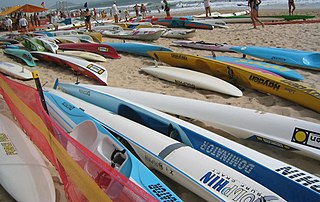
Surf lifesaving is a multifaceted movement that comprises key aspects of voluntary lifeguard services and competitive surf sport. Originating in early 20th century Australia, the movement has expanded globally to other countries including New Zealand, Ireland, South Africa, the United Kingdom. Surf lifesavers in Australia are colloquially known as "Clubbies".

Bondi Beach is a popular beach and the name of the surrounding suburb in Sydney, New South Wales, Australia. Bondi Beach is located 7 km (4 mi) east of the Sydney central business district, in the local government area of Waverley Council, in the Eastern Suburbs. It has a population of 11,656 residents. Its post code is 2026. Bondi, North Bondi, and Bondi Junction are neighbouring suburbs. Bondi Beach is one of the most visited tourist sites in Australia.

Bondi Junction is an eastern suburb of Sydney, in the state of New South Wales, Australia. It is 6 kilometres east of the Sydney central business district and is part of the local government area of Waverley.
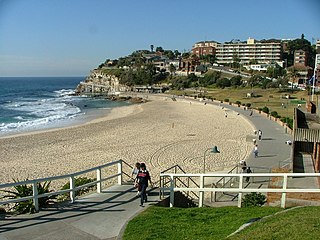
Bronte is a beachside suburb of Sydney, in the state of New South Wales, Australia. Bronte Beach is located 7 kilometres east of the Sydney central business district, in the Waverley Council local government area of the Eastern Suburbs.
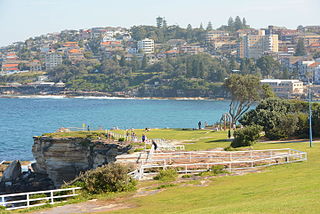
The Eastern Suburbs is the metropolitan region directly to the east and south-east of the central business district in Sydney, New South Wales, Australia.

Coogee is a beachside suburb of local government area City of Randwick 8 kilometres south-east of the Sydney central business district, in the state of New South Wales, Australia. It is also a part of the Eastern Suburbs region.

North Bondi is a coastal, eastern suburb of Sydney, in the state of New South Wales, Australia 7 kilometres east of the Sydney central business district, in the local government area of Waverley Council.
Bondi is a suburb of eastern Sydney, in the state of New South Wales, Australia, seven kilometres east of the Sydney central business district, in the local government area of Waverley Council.

Clovelly is a small beach-side suburb in Sydney's eastern suburbs, in the state of New South Wales, Australia. Clovelly is located 8 kilometres south-east of the Sydney central business district, in the local government area of the City of Randwick, within the Federal Division of Wentworth.

Surf Life Saving Australia (SLSA) is an Australian not-for-profit community organisation that promotes water safety and provides surf rescue services.
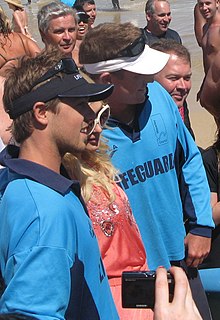
Bondi Rescue is an Australian factual television program which is broadcast on Network 10. The program which has aired since 2006, follows the daily lives and routines of the Waverley Council professional lifeguards who patrol Bondi Beach.
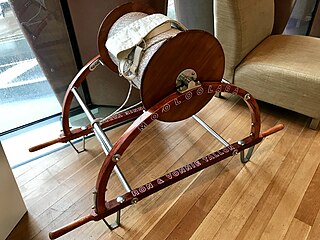
The surf life saving reel was a beach life saving apparatus from Australia.

Bronte Beach is a small but popular recreational beach in the eastern suburbs of Sydney, Australia. It is 2 kilometres south of Bondi Beach and north of the much larger Coogee Beach. A long distance ocean swimming event is held every December between Bondi Beach and Bronte. The three beaches are linked by a paved coastal footpath along the rocky cliff tops, much frequented by tourists and local runners and walkers. The beach is popular with surfers and despite the non rough surf, less abled swimmers can avail themselves of the bogey hole or rock pool towards the southern end of the beach. At the south end of the beach is a 30-metre ocean pool, one of the best known in Sydney. Also directly opposite from Bronte there are some popular cafes.
Wonderland City was an amusement park located at Tamarama, on Wonderland Avenue near the point at which it joins Fletcher Street, in Sydney, Australia. It opened on Saturday, 1 December 1906 and closed in 1911. At the time it was the largest open air amusement park in the southern hemisphere. The 20-acre (81,000 m2) amusement park was operated by theatrical entrepreneur William Anderson. During its operation the colossal playground had a balloon could go up to about 3,800 feet high. An enormous switchback railway and around the clifftop, a steam-driven miniature railway operated over about two miles (3.218688 km) of track. A large wooden bridge build over an artificial lake, the Alpine Slide would take you to "Rivers of the World", Seal Pond. An open air Roller Skating Ring, American Shooting Gallery. It was operated by electric light powered by its own steam plant, and the whole area was covered with thousands of gaily coloured lamps and described as a Fairy City. The first Surf "Gymkhana" Carnivals was held at Wonderland City organised by Bondi SBLSC on Saturday 11 February 1908. was dogged by controversy for its attempts using high barbed-wire fence blocked access completely to local swimmers from Tamarama Beach. Before being occupied by the amusement park, Tamarama Park was the site of The Royal Aquarium and Pleasure Grounds, commonly called the Bondi Aquarium.
The club was founded in 1903 and the movement has since spread to other parts of New South Wales and the rest of the country. The club rests on indigenous land and whilst there is no clear evidence for the name or names of the Eora people who lived in what is now the Waverley area, most sources agree on the Cadigal, but some sources name the Biddigal and Birrabirragal bands as well.
The Bondi Surf Bathers' Life Saving Club is Australia's oldest Surf Life Saving Club, founded in 1907. The club was officially established on 21 February 1907 at the Royal Hotel in Bondi Beach, Sydney, New South Wales. The clubs aim is to ensure "No Lives Lost" at Bondi Beach and is a volunteer organisation that patrols Bondi Beach from October to April every year.
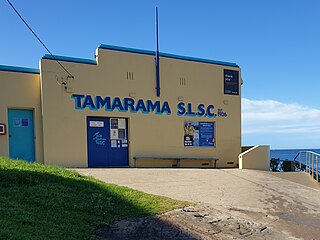
The Tamarama Surf Life Saving Club was founded in 1906 and operates at Tamarama Beach, Sydney. The clubhouse sits at the northern end of the beach.
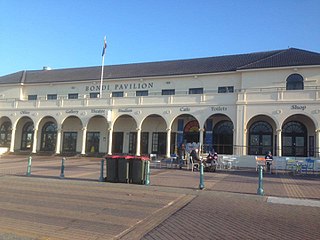
The Bondi Beach Cultural Landscape is a heritage-listed former Turkish baths, pavilion with dressing cubicles, dining rooms, sunbaking, shops and ballroom and now art gallery, pavilion, theatre and open air cinema located at Queen Elizabeth Drive, Bondi Beach, Waverley Municipality, Sydney, New South Wales, Australia. The pavilion was designed by Robertson and Marks, with Leith C. McCredie the architect. The Bondi Surf Life Savers' Club, erected c. 1934, was designed by Ross & Rowe. The Bondi Pavilion was designed by John Howie & Sons. The cultural landscape includes the beach itself, Bondi Surf Pavilion, Bondi Park and Bondi Surf Life Saving Club and the North Bondi Surf Club. The landscape was added to the New South Wales State Heritage Register on 23 May 2008.

Mackenzies Bay is a small inlet in the coast between Bondi Beach and Tamarama Beach in the Eastern Suburbs of Sydney, New South Wales. It forms part of the shoreline boundary of the suburb of Tamarama. Most of the time, it is a rocky inlet but, at times, depending on prevailing conditions, a sandy beach—known informally as Mackenzies Bay Beach or Mackenzies—comes into existence. Mackenzies Bay is also a well-known surf break.



















